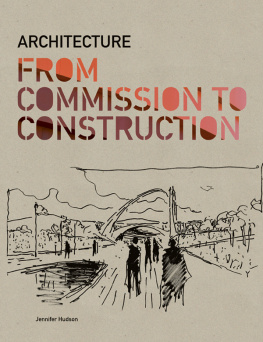ARCHITECTURE
FROM COMMISSION TO CONSTRUCTION

Jennifer Hudson

Published in 2012 by
Laurence King Publishing Ltd
361373 City Road
London EC1V 1LR
Tel: +44 20 7841 6900
Fax: +44 20 7841 6910
e-mail:
www.laurenceking.com
Copyright 2012 Laurence King Publishing Ltd
All rights reserved. No part of this publication may be reproduced or transmitted in any form or by any means, electronic or mechanical, including photocopy, recording or any infomation storage and retrieval system, without prior permission in writing from the publisher.
A catalogue record for this book is available from the British Library
ISBN: 978 1 85669 823 8
Design: Draught Associates
Printed in China
Authors acknowledgements
The following pages are dedicated to Jon Vanner who kept me sane during the writing of this book.
I would like to offer my gratitude to the architects featured for their time and patience in answering my endless questions, and for their support in supplying me with the visual material, much of it not normally released for editorial use. I would also like to thank my editor, Susie May, for all her hard work and advice, the copy-editor, Tessa Clark, and the production, publicity and marketing departments here at Laurence King Publishing. In addition, I would like to acknowledge the expertise of Helen Cliffe of Draught Associates in producing such a clear graphic design from the mountain of images supplied to her and for putting up with my many additions and amendments throughout the various layout stages. Without all of the above, Architecture From Commission to Construction would not have been possible.
CONTENTS
Introduction
A great building must begin with the unmeasurable, must go through the measurable means when it is being designed and in the end must be unmeasurableLouis Kahn
Generally speaking, architecture books fall into three categories. They are historical, theoretical or, most often, they concentrate on providing an analysis and criticism of completed buildings. In this selection of projects, however, I have sought to highlight the process involved in taking an architectural commission from concept through all the stages of design, development and construction to the end result.
The most obvious way to chart this progression was to consult the architects concerned, and the pages that follow are informed by direct interviews with lead architects as well as, in many cases, conversations with local architects and structural engineers. The selection was made on the basis of representing a rich background of practitioners and building genres. I have chosen individuals at different points in their careers, from published and lauded architects, who not only practise but also teach and theorize on their profession, to those who are less well known but whose work is nonetheless of a high quality. The content is international and the projects are diverse in scale, so the case studies express a variety of aspects of the built environment. Each one begins with an overview and is followed by extensively captioned illustrations that help the reader understand the methodologies adopted in each case: the project teams way of working together, be that collegiate or more hierarchical; how the brief was received and developed; presentation to the client (in some cases only one design was delivered while in others the architects opted to show alternatives for discussion); the development of the concept through sketching, physical model-making and computer-aided design (the last is still a hotbed of discussion some architects use the computer in the design process itself, others see it only as a drawing and presentation tool and a minority consider the employment of renderings to be fraudulent); detailed design; collaboration with, and input from, architects of record, consultants, specialists and contractors; and, finally, the time spent on site.
The temptation when considering the design process is to simplify it to the key plan of work stages outlined by the Royal Institute of British Architects or equivalent international professional bodies of architects. Although the specifics may vary from country to country, they essentially comprise a prepare, design, construct and use cycle that encompasses:
- Appraisal: The identification of the clients requirements and any possible constraints on development.
- Strategic brief: The preparation of the brief and a general outline of requirements, plus examination of the range of consultants and others to be employed on the project.
- First proposals: An outline of the proposals, and sketch plans to ensure they are functionally, technically and financially feasible.
- Schematic design: The development of the strategic brief into a project brief that includes the preparation of the concept design and the submission of planning applications and drawings.
- Final proposals: A detailed design of appearance and construction methods. This is the moment when building regulations have to be satisfied.
- Production information: Final decisions on every matter relating to the design, specification, construction and cost of the project.
- Tender documents and action: The identification of potential contractors and/or specialists for the construction of the project and the tender process.
- Mobilization: Handover of the site to the main contractor or project manager.
- Construction to practical completion: Operation on site to final construction.
- Completion: Final inspection to ensure the specifications have been met.
- Feedback: This allows for minor adjustments and for the final account to be settled.
However, to quantify the architects role as a logical series of tasks in such a sequential order would be to do him/her a disservice. Although a cognitive procedure is necessary, it is interesting to observe (as the pages that follow attest) the extent to which the phases overlap and initial objectives are found to have more than one correct solution as the process advances. Problems that arise are understood through the attempts to solve them, and can become generative factors in the design. It is often the case that an architect makes refinements up to and during construction. Although from the outset he or she holds in his or her minds eye an approximation of the outcome, each project is a journey that only the most inquisitive, creative and open of minds can navigate to address the issues, from technical to budgetary concerns, that are met along the way.
Above all, an architect can be likened to the conductor of an orchestra. Many of those published in this book are instantly recognizable names and it is all too easy to presume theirs is the sole signature on a building; but, of course, this is not so. Architecture is a joint venture both in-house (in the formation of a project team, how it is organized and the methods the principal and designers adopt to communicate with each other) and in collaboration with outside agents. Whether an architect is involved in a design-build or in a design-build bid contract where he/she hands over to another party (local architect or project manager) after detailed design for the tender and construction process to be completed, the success of a project is dependent on how well the architect can communicate and inspire confidence.
A mutually supportive relationship between architect and client regardless of whether the latter is an individual or a committee representing an institution is paramount. Some clients have very specific demands while others are less clear. It is the architects role to outline possibilities based on his/ her professional experience and aesthetic expression while delivering what clients think they want or, in many instances, what they can hope to expect. At its most rewarding, the liaison can be highly interactive and inventive, but in all cases it needs to be close and trusting. The best projects result from an open and communicative cooperation from first meeting to delivery. The more problematic schemes are those that are large-scale with extended schedules, when members of a client team may change with a concomitant loss in continuity, lack of personal commitment and little appreciation of the core concept. If the client is not going to occupy a building, the architect needs to assess the requirements of the user through observation-based evidence, participatory consultation with the third party or by imagining him/herself to be an occupant of the finished project and deciding what will make it appealing.
Next page














